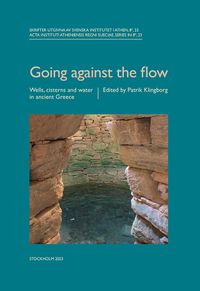
endast ny
Going against the flow
Going against the flow. Wells, cisterns and water in ancient Greece Edited by Patrik Klingborg Despite the prevalent picture of the water supply in the ancient world as being dominated by fountains and aqueducts, the large number of excavated wells and cisterns show that these were the primary water sources for most individuals. Yet, little research has been done on their construction, function and use. This prompted the organization of the workshop Going against the flow. Wells, cisterns and water in ancient Greece, held at the Swedish Institute at Athens on 28–29 September 2017, and subsequent publication of the contributions in this volume. The ten papers presented here offer new evidence as well as a wide range of new perspectives on the use and function of wells and cisterns in ancient Greece. Considering the ubiquity of these installations in every type of setting during antiquity, from pan-Hellenic sanctuaries and civic centres to domestic workshops and remote farmhouses, it is hoped that the breadth of interest among the authors will allow other scholars to advance their own work further, illuminating new and exciting aspects of life in ancient Greece. Contents Acknowledgements Patrik Klingborg, ‘Introduction. Wells, cisterns and the water supply in ancient Greece’, 9-30 Martin Finné& Inga Labuhn, ‘Hydro-climate in the Aegean from 700 BC to AD 300. Links between climate and freshwater availability’, 31-54 Yannis Lolos, ‘Water provisioning in a marine terrace environment. The cases of Corinth and Sikyon in the north-eastern Peloponnese’, 55-75 Pavlos Karvonis, ‘The water supply in the Late Hellenistic houses of Delos’, 77-90 Jutta Stroszeck, ‘The cisterns of the Athenian Kerameikos. Distribution and recent documentation’, 91-112 Stephanie Kimmey, ‘The Nemean wells. Water management and sanctuary deposition’, 113-134 Johanna Fuchs, ‘The water supply of the Heraion of Samos’, 135-159 Patrik Klingborg, ‘Wells and cisterns in Greek literature’, 161-178 Hamish Forbes, ‘Cisterns and loutses in a traditional Peloponnesian village. Aspects of function, use and monumentality’, 179-202 Dylan K. Rogers, ‘Epilogue. The social side of Greek water collection’, 203-221
Utgiven: 2023
ISBN: 9789179160678
Förlag: Publikationsnämnden vid de Svenska Instituten vid Rom och Athen
Format: Inbunden
Språk: Engelska
Sidor: 222 st
Going against the flow. Wells, cisterns and water in ancient Greece Edited by Patrik Klingborg Despite the prevalent picture of the water supply in the ancient world as being dominated by fountains and aqueducts, the large number of excavated wells and cisterns show that these were the primary water sources for most individuals. Yet, little research has been done on their construction, function and use. This prompted the organization of the workshop Going against the flow. Wells, cisterns and water in ancient Greece, held at the Swedish Institute at Athens on 28–29 September 2017, and subsequent publication of the contributions in this volume. The ten papers presented here offer new evidence as well as a wide range of new perspectives on the use and function of wells and cisterns in ancient Greece. Considering the ubiquity of these installations in every type of setting during antiquity, from pan-Hellenic sanctuaries and civic centres to domestic workshops and remote farmhouses, it is hoped that the breadth of interest among the authors will allow other scholars to advance their own work further, illuminating new and exciting aspects of life in ancient Greece. Contents Acknowledgements Patrik Klingborg, ‘Introduction. Wells, cisterns and the water supply in ancient Greece’, 9-30 Martin Finné& Inga Labuhn, ‘Hydro-climate in the Aegean from 700 BC to AD 300. Links between climate and freshwater availability’, 31-54 Yannis Lolos, ‘Water provisioning in a marine terrace environment. The cases of Corinth and Sikyon in the north-eastern Peloponnese’, 55-75 Pavlos Karvonis, ‘The water supply in the Late Hellenistic houses of Delos’, 77-90 Jutta Stroszeck, ‘The cisterns of the Athenian Kerameikos. Distribution and recent documentation’, 91-112 Stephanie Kimmey, ‘The Nemean wells. Water management and sanctuary deposition’, 113-134 Johanna Fuchs, ‘The water supply of the Heraion of Samos’, 135-159 Patrik Klingborg, ‘Wells and cisterns in Greek literature’, 161-178 Hamish Forbes, ‘Cisterns and loutses in a traditional Peloponnesian village. Aspects of function, use and monumentality’, 179-202 Dylan K. Rogers, ‘Epilogue. The social side of Greek water collection’, 203-221
Ny bok
446 kr469 kr
5% studentrabatt med Studentapan
Begagnad bok (0 st)
Varje vecka tillkommer tusentals nya säljare. Bevaka boken så får du meddelande när den finns tillgänglig igen.



